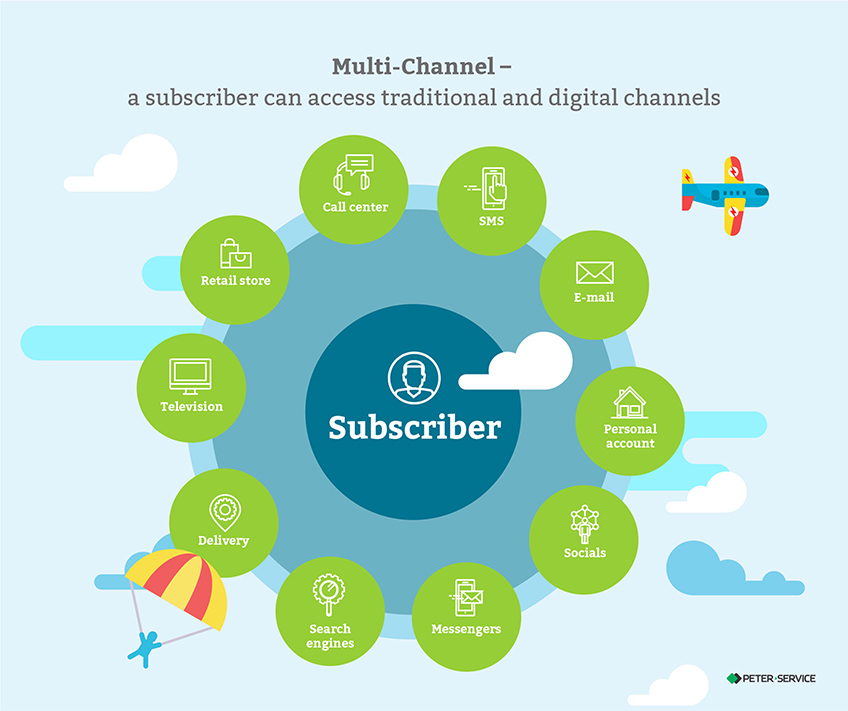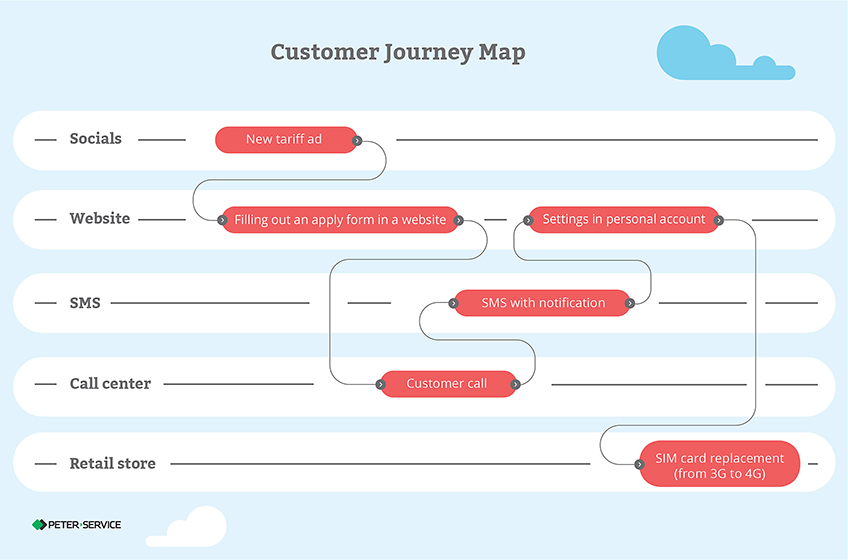Blog: All you need to know about Omni-Channel and Opti-Channel
Operators have committed to supporting subscribers in any situation.
Availability of Omni and Opti channels is becoming a basic feature for companies with multi-million subscriber bases. Operator's pursuit of optimizing their own channels is as strong as that of banks and retailers. To do that, they need to significantly transform their approach making Customer Experience the core of their business. Introducing Omni and Opti channels should become a significant share of this change.
Multi-Channel: the birth of the multi-channel approach
Before the massive spread of the Internet, major companies could not support a wide variety of channels to interact with end consumers. Ordinary telephone remained the most innovative channel through which a customer could contact the company by making a phone call. Other modern channels. e.g. television, did not offer feedback and could serve merely as a means of advertising, or, at best, via TV it was possible to organize a TV shop or quiz.
Everything changed with the advent of digital technologies. From the beginning, websites and e-mail followed by social networks, mobile apps, and messengers overwhelmed traditional business. Subscribers wanted to use the new channels to communicate not only with each other, but also with companies. The businesses that were first to embark on this trend could offer innovative features to their customers.
CPSs moved from the Single-Channel concept (a store as the main point of sale and communication with customers) to Multi-Channel making all digital channels available to customers. A question that came up quickly was whether backbone systems of CSPs are prepared for this change?

Very soon it became obvious that neither traditional points of sale (stores), nor CSP's IT systems were ready to face the changes that had taken place. The emergence of Multi-Channel became a Pandora's box, with challenges lining up one after another. Many channels were not quite efficient being more like a "bait" for advanced users: many systems connected to different channels were not aligned; in the long run, it was still more efficient to address any problem using traditional channels – a call center or a personal visit to a store. The introduction of a new approach, dubbed Omni-Channel, provided a way-out of this dead end.
Omni-Channel: wins and failures
Considering that "Omni" means "everything", this approach was grounded on the spread of a single way of communication with customers to all channels and fixing gaps in aligning them. The introduction of Omni-Channel was best fueled by spreading the idea that customer experience must become the key focus of operators.
Customers should get what they need through any channel, but channel hopping must not mean that they would need to make the entire journey from the start. A subscriber had to have a possibility of seamless transferring among channels. This possibility was facilitated by the effort to improve customer journey from one channel to another in attending to their standard tasks.

Omni Channel had further advantages. Applying this approach CSPs began collecting data linked to every subscriber. These were not just their query number, but also the data on how their problem had been addressed and solved. Call center workloads decreased radically. A new role was given to retail which, for a significant number of subscribers, was turning into an order pick-up point or, simply, a show-room for those preferring to shop online from their home and use delivery services.
The introduction of Omni-Channel took serious efforts – it was necessary to create a common universal base covering all customers and their actions (earlier systems could differ by channels), enable moving orders or customer requests across different channels, and improve usability of digital channels. This required significant changes of IT systems – at least building an extension above them to run faster CRM, or, ideally, a full refurbishment, already based on the new demands in enhanced customer experience.
The omni channel approach also necessitated working changes for staff who had to learn to operate new complex systems and become more sensitive to subscribers. This proved to be of top importance to ensure a seamless switch across different channels.
Yet, not everything turned out to be perfect – satisfaction levels of advanced users increased, subscriber retention became easier, but CSPs that had adopted the Omni-Channel model only as an improved Multi-Channel faced certain challenges. To improve such criteria as customer demands prediction, personalization, detection of customers, and optimality of each channel, it was necessary to put more efforts in such areas as Big Data, artificial intelligence (AI), and machine learning.
Companies that had implemented Omni-Channel faced another issue – the value of numerous channels was not obvious to subscribers. It turned out that a small number of channels is enough to satisfy the subscriber, while the value decreased with more channels onboard. This fact, together with the need for developing new technologies, kick-started the emergence of the Opti-Channel (or, Optimum Channel) approach.
Opti-Channel: on the way to perfection
Omni channel approach led CSPs to dramatically improve the operation of each channel, ensure a seamless switch across them, enhance digital channels (e-mail, SMM, online stores, personal accounts). Yet, in such a system a user was still on his own. He had to address appearing questions himself, though it became easier than at the times of plain multi-channels.
Following a wide spread of Omni-Channel, CSPs wanted to get more personalization and a better understanding of their subscribers, and subscribers wished to communicate via a single channel which was the most suitable for them. To address the first and the second task, it was necessary to use "heavy weapons" – AI, Big Data, and predictive analytics.
This would help CSPs learn which channel could handle customer's tasks and how this channel improves CSP's business indicators, e.g. facilitates the promotion of added value services. Moreover, CSPs had to be better aware about their clients' demands and typical problems. And, finally, they needed to collect maximum information on specific subscribers – a portion from their history and a share from real-time indicators.
This could facilitate providing subscribers with services they needed at a certain moment through the most means they like best, based on their preferences, in general, and on specific circumstances at this particular moment. Further, if CSPs learned to predict the emerging situation and give customers what they wanted in advance, clients would get what they wanted almost instantly which would spare them live conversations to explain their problems.
As fantastic as it may sound, of course, this was the approach that laid the groundwork for Opti-Channel, or the optimum channel. The technology is still being developed and few vendors can offer it. CSP's interest in Opti-Channel is only starting to emerge: most of them are finalizing their transition to Omni, while lagging markets are totally dominated by Multi-Channel.
Based on the number of requests in Google in September 2017, Omni-Channel generated 16 million results, while Opti-Channel – around 700 thousand.
Yet, future lies exactly with this approach, as users are increasingly using their smartphones for a variety of purposes and CSPs are unlikely to lose this opportunity of becoming the main window for multiple services that customers need. The introduction of Opti-Channel can simplify addressing routine issues such as SIM card replacement, but it can also enable a deep dive in customers' concerns, and open new opportunities to satisfy them through operators' existing channels or by opening new channels.
What do chatbots have to do with all this
Can it be that just one channel will be the optimum channel serving all purposes? This is possible with the growing spread of messengers and expansion of their functionality. Already today, many businesses are opting for messengers trying to transfer all their communication to them. The best example of this is WeChat, the most popular MIM in China, through which it is possible not only to talk to friends and read news, but also to pay in shops, settle bills, order food or taxi, and transfer money to friends and relatives.

The appearance of chatbots became another impetus for messengers' popularity which are beginning to look like the Opti-Channel's Holy Grail. A chatbot can replace almost all functions of a call center, route customers' queries to appropriate channels and handle much of its work, if necessary, also providing the needed result to the customer right through the messenger.
It is easy to observe that both chatbots and Omni-Channel require the same tools to develop – machine learning, Big Data, AI solutions. Operators can successfully combine the development of chatbots and omni-channel and further join these two areas by not just implementing common tools to support them, but also by using chatbots as an optimum channel.

Opti-Channel came later than Omni-Channel, with Multi-Channel being their logical continuation. In the recent five years, Omni-Channel has managed to go mainstream and become an essential part of operators' digital transformation. Opti-Channel moves operators even further from the communications world to the world of IT requiring completely new skills.
If operators can perform a successful transition to Opti-Channel, this means they are well aware of the importance of new IT achievements that put the digital world to a new level, with artificial intelligence, customer behavior prediction, building the most convenient innovative interfaces, and a deep dive in the concerns of ordinary subscriber. This can make CSPs one of the most powerful players in the future market where banking, mobile services, retail and the service market will be closely intertwined. The fundamental idea of digital transformation lies in the radical re-birth of CSPs, and very soon we will see where the road that started with the introduction of Opti-Channel will take them.
Stay connected!